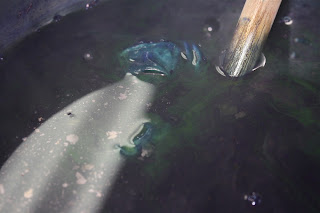Yesterday at the Weaving and Fiber Arts Center, I taught a class on natural dyeing with indigo and onion skins. As always with natural dyes, the results were magical. To my eye, we achieved some wonderful colors -- jonquils, saffron, green grass, flax flowers, blue skies, and late twilight.
Working with vats of onion-skin dyes and indigo, we created base colors of either yellow or blue. But even with two simple dye recipes, the colors varied greatly, depending on the fiber used and the amount of time it was in the dye bath.
The indigo vat: a powerful brew!
A silk scarf that was lying in the onion-skin vat for -- who knows -- an hour?
About the silk scarf above: We immersed it in the onion-skin vat and then forgot about it! I love the serendipity of "mistakes" like this. The color was vibrant. Hoping to get a photo in natural light, I took it outside to try to capture the color, which was almost a saffron yellow.
The class was titled "Ombre Dyeing with Indigo and Onion Skins," and the aim was to achieve a gradation of three or more colors on fiber or fabric.
Leslie Moran's commercial cotton fabric, dyed first in onion skin and then in indigo.
Judith Trolley tried some ombre-dyeing on Black-Faced Leicester roving, to be handspun and used as a warp.
We achieved colors from pale yellow to deep saffron, from light green to dark teal, from pale blue to midnight, some of which you can see in the pieces on the drying rack below.
For me, the happiest surprise happened with another "mistake." I had a long piece of silk gauze, which I immersed in the indigo vat and then immersed in the onion-skin vat, to achieve random sections of blue and green -- which I got, vividly, and did not like. (See the image in the bottom-right corner of the photo above.) So I kept dipping it in indigo, maybe five times, then letting it oxidize on the rack, hoping to get a deep blue color.
Except I forgot about it as I was teaching -- left it bunched up in the sink, without rinsing or placing it on the rack to oxidize. Later, when I found it, the thiox (the discharge chemical in the indigo bath) had worked magic, marbling and mixing the colors. You can see the results in the photo below (and at the start of this post):
If you've seen the masterpieces of Carter Smith, who uses acid dyes, you'll know what I'm striving for. This technique -- starting with indigo, immersing it in another dye vat, then creating shibori resists (on purpose, rather than by mistake) -- is worth exploring.










